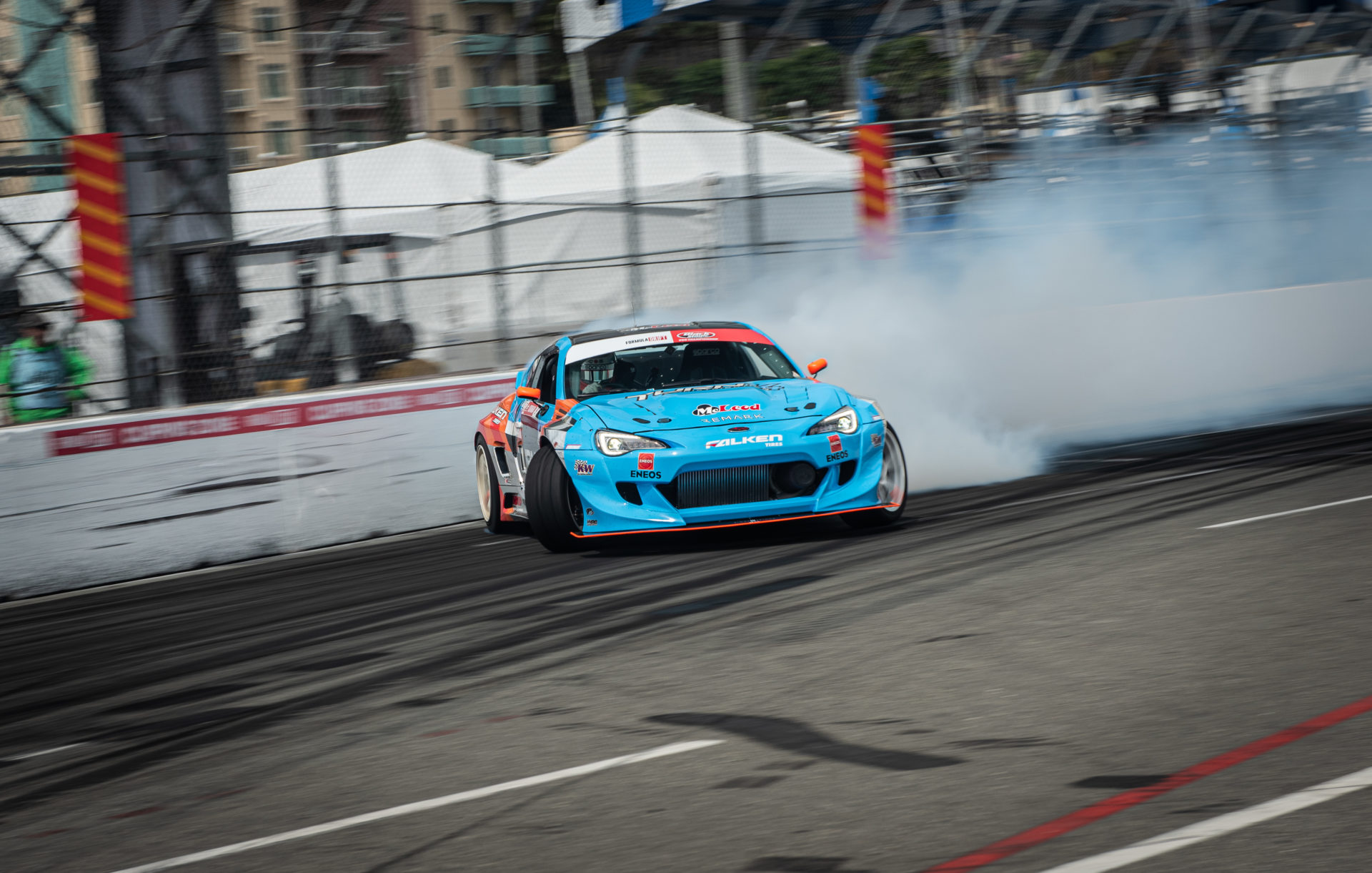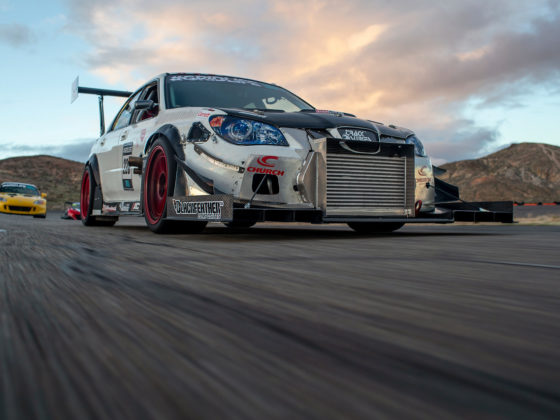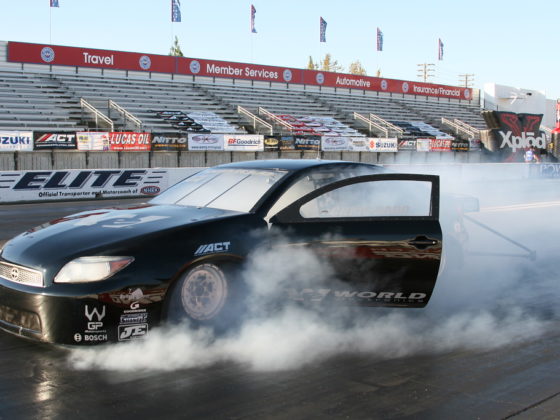
We have been using King Bearings almost exclusively in our engine builds for the past several years and have been getting extremely good results with them. So we wanted to show you how King Bearings hold up in abuse in what could possibly be some of the worst, demanding use in Motorsports, Pro Drifting. We have been building and maintaining Dai Yoshihara’s engines from his Turn 14 Distribution, Falken Tire BRZ for the last several years and we recently serviced one of his engines that had gone an unusually extremely long time between service intervals.
At the beginning of the 2017 season, we had difficulty in getting our preferred custom billet LS stroker crank in a timely manner. This caused us to miss getting a fresh motor in the car in time for the start of the season. For Formula Drift, the first 4 out of 8 rounds of the season are, with the exception of Long Beach, on the East Coast and held very close together in time. When you consider the transit time, there is only a few days available per event for a west coast team like ours for prep in between events. With the old engine that had a full season on it, plus many test sessions and a bunch of demo time still reading good compression and leak down with good oil pressure, it was decided to keep the old engine in the car until FD round 5 unless it started to perform unsatisfactorily.
This meant that the old engine was subjected to 1.5 seasons of use, plus a lot of preseason and postseason testing. Also included was a week of drift demos for Falken at the SEMA Show and a few other jaunts for marketing photo sessions and sponsor commitments which are perhaps actually almost two seasons of cumulative running time! This is an unprecedented amount of time between engine service intervals for us. As an example, before MotoIQ took over Dai’s engine program, the previous famous boutique LS engine builder’s motors would be nearly done and hammered after only half a season and would require a mid-season replacement and refresh. In particular, the engine’s bearings would be totally worn and the crank often had to be machined undersize due to journal damage.
If you didn’t know, Pro level drifting is brutal on engine components. Forced induction, plus high revs and a continuous, highly loaded duty cycle are super hard on the engine’s internals. In drag racing, the load on the engine is only for something like 10 seconds per pass. A drift car has to run for a minute or so going full tilt under hard G forces going in all directions, then be subjected to extended idling and heat soak with more hard running many, many times per event. Most drift cars also run on ethanol-based fuel so fuel dilution of the oil is always an issue as this compromises the oil film protecting the bearings.
The engine is run against the rev limiter frequently and hard and that jackhammering is very tough on the entire engine from the crank to the valvetrain when run at Formula Drifts 1000 plus hp. Driving techniques like clutch kicking and violent changes in RPM from the tires spinning and catching traction put severe torsional and harmonic loads on everything in the engine causing all sorts of potential areas of failure. In a drift engine, the loads cause the crank and even the block to flex and these things must be accounted for in the build. The flexing also means that the engines main bearings must endure occasional contact with the crank journals.
Dai’s engine is a racing engine based on LS architecture. The block is an alloy unit made by RHS with AllPro cylinder heads and all billet internals. We have written about it here. The engine is run up to 7700 rpm which is a lot for a 4.250″ stroke engine. The engine is run at around the 1000 hp level, most of the time at up at around 12 psi of boost although it can run at higher boost levels. Due to the restrictive FD rules, the engine is used as a stressed member of the chassis and held in place via a motor plate.
Another interesting note is that these pictured used bearings are King’s older XP bearings. About a year and a half ago these bearings have been superseded by King’s XP pMax-Black bearings which have an overlay with 5% copper and an improved nanostructure that contributes to the new bearings having a 24% higher load bearing capacity than the bearings shown here. This overlay supersedes the old style black coated bearings.
The old King bearings were a premium tri-metal tin, copper, lead mixture over a steel backing with a thin black organic dry film lubricant overcoating that was intended a protective layer to reduce the potential for scuffing from the crank journals during break-in, start-up, and extreme use when everything may be flexing around. The old King bearings had a higher tin content for increased load bearing capacity over other performance bearings. Let’s see how the old style King bearings held up to extreme abuse for over 3x the length of time that other bearings have lasted under the same conditions.

First, let’s look at the rod bearings. They are in great shape with the dry film lubricant anti-scuff coating totally intact. Rod bearings often get beat up the worst in an engine as they get a timed oil supply from the main bearings and are subjected to centrifugal loads that tend to throw off oil.

A curious phenomenon that we noted on the rod bearings is that the top coating on every set of rods had this circular wear point. This is the worst of the rod bearings. We theorize that this corresponds with the oil feed hole in the crank and when the crank isn’t feeding the rods depending on where the crank is in its rotation, the hydrodynamic layer gets thinner in the vicinity of the oiling hole allowing for more bearing wear in this pattern.




15 comments
I’m calling block flex the main culprit here! This looks like flex in the direction of the crank, with the front haf twisting in the opposite direction compared to the other side. Since its a blok thats part of the main structure, it’ll probably be torquing itself.
Most likely time for a stiffer block!
A stiffer block like an LSX would be nice but these cars have to handle well too and that’s another 80 lbs on the nose that I don’t want to have. Since we have exceptional reliability and low maintenance, perhaps the best of any team in the series, I will put up with bearing replacement once a season!
80 lbs is a shit ton of weight! Wouldn’t it be possible to make a rigid frame where it can be bolted to? In essence both banks are trying to extend the V outward. So a front and back lower mount, and preferably 2 mounts all across the heads? Lower mounts are the most efficient though. And if you really would like to test if you need the upper mounts: Use some thin aluminum sheet and rivet it to the frame. If your using studs, attach the other side to the head bolts. You can see how much deflection there is by looking at the ripples after a run. You could in essence use paper, as long as you re-enforce the places where you attach it to the engine and frame. Or just place a camera under the bonnet (or run without a bonnet during testing and just slow motion the footage? By then you have at least confirmation that flex is the problem. Although I highly doubt it is anything else.
As for flex in itself: I actually like flex for the most part: I kind of look at it as a pressure relief switch: I’d rather have flex then breaking stuff!
None of that would be legal under the rules. The engine is doing exceptionally well and this engine just happened to be run a long time so I can live with the wear which is still exceptional.
I cant blame you for it! If it works within reasonable you might as well leave it!
EDIT:
Had to look up the engine bay: Would it be possible to use to “strut braces over the engine? And if so, make then bolt down in stead of welded, so you can still remove them if neccesary? From there on out extendtubes front and rear to the sides of engine and bolt them down. make the top tubes as rigid as possible (because you don’t want to warp the struts, which I think will happen if your not carefull) and use thinner tube that bolts to engine. 16 bolts total = 2 per side per strutbracebrace, making 8 total. 2 per side per engine brace, making 8 total.
FD will not let us use any sort of auxiliary bracing forward of the firewall. Bolt on or not. We have been busted for this before too!
You could pass some tubes inside the hood structure, technically not bracing, easily removable, hide it under some a sheet of carbon and some heat reflecting tape… The 5/8″ steel hood pins might give it away though 🙂 Just thinking out loud here…
A rigid hood can be forced through the windshield in a crash and decapitate the driver. This is the reason why OEM hoods have buckle points and cowl retention hooks and slots. Many people used to get killed this way. The stressed member engine is legal and more effective and does not add any weight or complexity.
Another thing is that we like to be able to do quick engine swaps if needed. Our whole car is designed around being repairable and easy to maintain in between rounds and in the shop as well. In drifting once competition starts we are only allowed 5 minutes for repairs in total for the entire competition.
I thought as much about repair time. And I wouldn’t have anything less. Taking everything off just to get to one piece is a pain in the ass to say the least. But with 5 minutes every second counts, so it becomes a question of: “How many times do I take those 5 minutes, and can I risk it?” And since you have your feet on the ground over there, you are a way better judge at that then I am.
From other bearings I’ve seen, it appears WPC treatment seems to work better.
What do you think, Mike?
Well, remember that you are looking at wear over 3x the previous service internal and this is an older design of bearing.
Understood…but I’m guessing the same bearing design with WPC would show improved wear.
It would take off the black coating and I didn’t want to do that. I have done it with ACL and OEM bearings with good results.